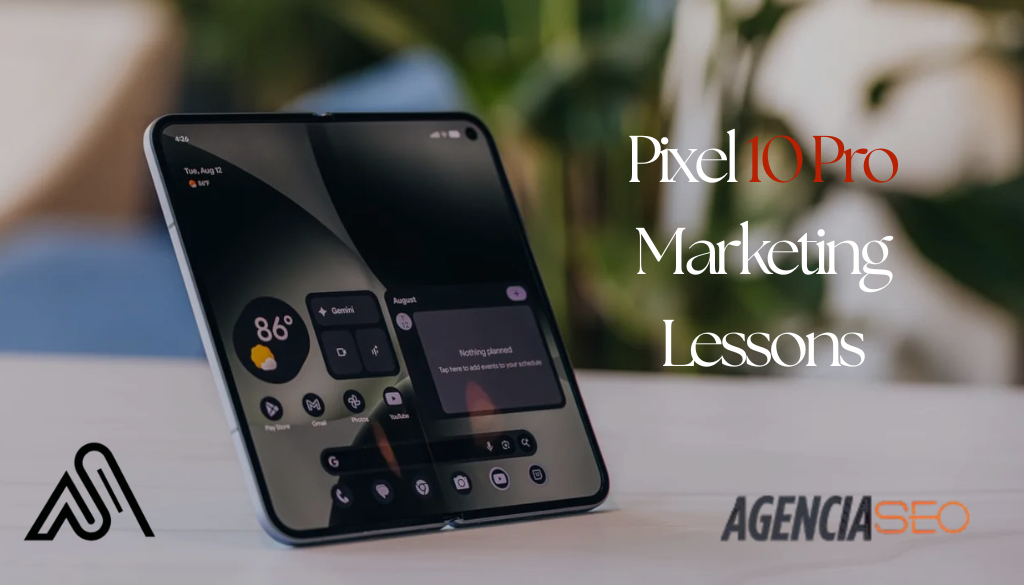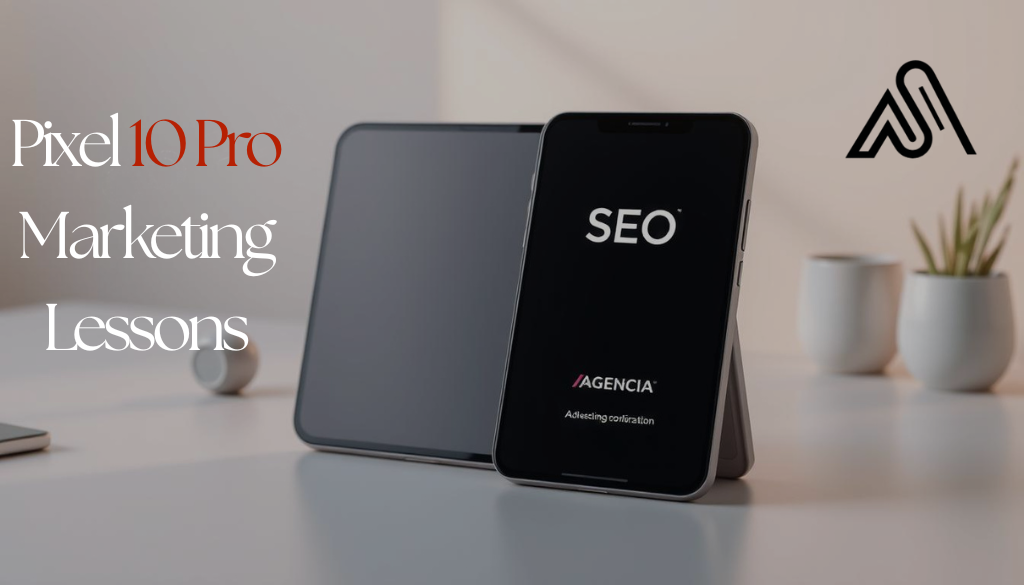Pixel10 Pro offers valuable marketing insights for businesses aiming to boost their SEO strategy by leveraging the latest tech trends. By examining Google’s marketing approach, businesses can gain a competitive edge.

Pixel10 Pro launch highlights the importance of staying up-to-date with the latest technological advancements and incorporating them into your SEO strategy. This can significantly enhance your online presence.
Table of Contents
What Is The Evolution of Tech Marketing in 2025 ?
As we step into 2025, the tech marketing world is witnessing a paradigm shift. The way technology is marketed has evolved significantly, with product launches playing a crucial role in shaping digital marketing strategies.
How Tech Product Launches Shape Digital Marketing ?
Tech product launches have become pivotal events that influence digital marketing trends. Companies like Google set the stage with innovative products, forcing competitors to adapt and innovate. The launch of products like the Pixel10 Pro demonstrates how integrated marketing strategies can create a buzz around new technology.
Ready to Transform Your SEO Like Google Did with the Pixel 10 Pro?

Have you ever wondered why the Pixel 10 Pro launch created such a massive buzz worldwide? It wasn’t just about showcasing a new phone—it was a masterclass in marketing strategy.
Google used AI integration, voice search optimization, immersive content, and community-driven engagement to position the Pixel 10 Pro as more than a device—it became a trendsetter.

This same approach can be applied to your business. By leveraging the latest tech trends and tailoring your SEO strategy and consume content, you can dominate your market just like Google dominates the tech world.
At Agencia SEO, we help businesses take these powerful lessons and turn them into measurable results. From AI-powered content strategies to voice-search optimization and trust-driven campaigns, we craft SEO solutions that make your brand impossible to ignore.
👉 Start your Pixel 10 Pro-inspired SEO strategy today with Agencia SEO
Why Marketers Should Pay Attention to Google’s Strategies
Google’s marketing strategies are closely watched by industry experts. By analyzing these strategies, marketers can gain insights into effective SEO techniques and campaign execution. Google’s focus on AI and machine learning is a key area that marketers should explore.
Key Marketing Trends from Recent Tech Releases
| Trend | Description | Impact on Marketing |
|---|---|---|
| AI Integration | Incorporating AI into products and services | Enhances customer experience and personalization |
| Enhanced Security Features | Focus on data protection and privacy | Builds trust with consumers and differentiates brands |
| Immersive Technologies | Use of AR and VR in product demonstrations | Creates engaging and memorable marketing experiences |
By understanding these trends, marketers can develop more effective campaigns that resonate with their target audience and stay ahead of the competition.
The Pixel10 Pro Launch Strategy Breakdown
Google’s Pixel10 Pro launch strategy offers valuable insights into effective market positioning and competitive differentiation. By carefully segmenting their target audience and tailoring their messaging tactics, Google created a significant buzz around the product.
Google’s Market Positioning and Competitive Differentiation
The Pixel10 Pro was positioned as a premium device, emphasizing its advanced camera capabilities and AI-powered features. Google achieved competitive differentiation by highlighting the unique aspects of their product, such as the Tensor chip and enhanced software integration.
Target Audience Segmentation and Messaging Tactics
Google effectively segmented their target audience into distinct groups, including tech enthusiasts and professional photographers. They then crafted messaging tactics that resonated with each group, showcasing the Pixel10 Pro’s capabilities through targeted marketing campaigns.
Pre-Launch Hype Building Techniques
To build anticipation for the Pixel10 Pro, Google employed several pre-launch hype building techniques. These included:
- Leaking information through cryptic social media posts
- Hosting exclusive preview events for select media outlets
- Creating a countdown on their official website
These strategies generated significant excitement and anticipation among the target audience.
By analyzing Google’s launch strategy for the Pixel10 Pro, businesses can gain valuable insights into effective market positioning, target audience segmentation, and messaging tactics. These lessons can be applied to enhance their own product launches and marketing campaigns.
AI-Powered Content Strategies from Google’s Playbook
With the Pixel10 Pro, Google has demonstrated the potential of AI in enhancing content marketing efforts. This approach is revolutionizing how businesses create and optimize their content.
Showcasing AI Features
Google’s Pixel10 Pro launch highlighted the device’s advanced AI capabilities, such as improved camera features and personalized user experiences. These features were showcased through various marketing campaigns that emphasized the role of AI in enhancing user interaction.

Implementing AI-Focused Keywords
To leverage AI-powered content strategies, businesses must incorporate AI-focused keywords into their content. This involves understanding the search intent behind AI-related queries and creating content that addresses these needs.
Creating Content That Addresses AI-Related Search Intent
Creating content that aligns with AI-related search intent requires a deep understanding of how users interact with AI-powered tools. Businesses should focus on developing content that provides value to users by answering their questions and solving their problems.
| AI-Related Search Intent | Content Strategy |
|---|---|
| Understanding AI capabilities | Create informative blog posts and guides |
| Using AI for problem-solving | Develop case studies and success stories |
| AI technology updates | Publish news articles and press releases |
By implementing these strategies, businesses can improve their visibility in search results and provide valuable content to their audience.
Visual SEO Lessons from Pixel10 Pro’s Camera Marketing
By examining the Pixel10 Pro’s camera marketing, we can uncover effective visual SEO strategies to enhance your digital marketing efforts. The Pixel10 Pro’s campaign showcases how visual content can be optimized to capture audience attention and improve search engine rankings.
Translating Camera Specs into Visual Content Opportunities
The Pixel10 Pro’s advanced camera features, such as its high-resolution sensor and enhanced low-light performance, offer a wealth of opportunities for creating engaging visual content. By highlighting these features through high-quality images and videos, businesses can attract potential customers and drive traffic to their websites.
Key visual content opportunities include:
- Detailed camera spec sheets
- High-quality product images
- Sample photos taken with the device
- Comparison videos with other flagship models
Image Optimization Techniques Inspired by Computational Photography
Computational photography techniques used in the Pixel10 Pro, such as advanced image processing algorithms, can inspire image optimization strategies. By optimizing images with relevant alt tags, descriptions, and file names that include target keywords, businesses can improve their visual content’s visibility in search results.
Structured Data for Visual Content Enhancement
Implementing structured data for visual content can significantly enhance its visibility. By using schema markup to provide search engines with additional context about the content, businesses can increase the chances of their visual content being displayed in rich snippets or other enhanced search results features.
For example, using schema markup for images can help search engines understand the content and context of the images, making them more discoverable.

Voice Search Optimization: Google Assistant Integration
Voice search optimization is becoming increasingly important with the rise of Google Assistant-enabled devices like the Pixel10 Pro. As voice technology continues to advance, it’s changing the way people interact with their devices and search for information online.
How Voice Technology Changes Search Behavior
Voice technology is altering search behavior by making it more conversational. People are now using full sentences and questions when searching, rather than just keywords. This shift requires businesses to adapt their SEO strategies to accommodate the growing number of voice searches.

Optimizing Content for Conversational Queries
To optimize for voice search, businesses need to focus on creating content that answers conversational queries. This involves using natural language and long-tail keywords that reflect how people speak.
Featured Snippet Strategies for Voice Search Dominance
Featured snippets are crucial for voice search dominance, as they provide the answers that virtual assistants like Google Assistant read out to users. To increase the chances of getting a featured snippet, businesses should:
- Use clear and concise language in their content
- Structure their content with headings and subheadings
- Provide direct answers to common questions
| Optimization Technique | Description | Benefit |
|---|---|---|
| Conversational Keywords | Using long-tail keywords that reflect natural speech | Increases relevance for voice searches |
| Clear Content Structure | Organizing content with headings and subheadings | Improves readability and chances of featured snippets |
| Direct Answering | Providing straightforward answers to common questions | Enhances the likelihood of being read out by virtual assistants |
By implementing these strategies, businesses can improve their voice search optimization and stay ahead in the competitive digital landscape.
Mobile Experience Lessons from the Pixel10 Pro Design
As mobile devices continue to dominate the digital landscape, the Pixel10 Pro’s design principles can inform effective mobile SEO strategies. The Pixel10 Pro’s design offers valuable insights into creating a seamless mobile experience, which is crucial for businesses looking to stay competitive.
Responsive Design Principles from Google’s Hardware
The Pixel10 Pro’s responsive design is a key factor in its success. Google’s approach to hardware design can be applied to web development, ensuring that websites are optimized for various devices and screen sizes. A responsive design adapts to the user’s environment, providing an optimal experience regardless of how users access the site.
Key principles of responsive design include:
- Flexible grids and layouts
- Images that scale
- Media queries to adapt to different screen sizes
Page Experience Signals That Impact Mobile Rankings
Page experience signals play a crucial role in mobile rankings. Google considers factors such as loading speed, interactivity, and visual stability when ranking websites. By optimizing these signals, businesses can improve their mobile rankings and drive more traffic to their site.
| Page Experience Signal | Description | Optimization Technique |
|---|---|---|
| Loading Speed | How quickly a website loads | Minify CSS, compress images |
| Interactivity | How quickly a website responds to user input | Optimize JavaScript, reduce server response time |
| Visual Stability | How stable the layout is during loading | Avoid inserting content above existing content |
Core Web Vitals Optimization Techniques
Core Web Vitals are a subset of page experience signals that measure loading speed, interactivity, and visual stability. To optimize Core Web Vitals, businesses can use techniques such as:
- Optimizing images and videos
- Minifying and compressing CSS and JavaScript files
- Leveraging browser caching
By focusing on these areas, businesses can improve their mobile experience, driving more traffic and conversions. As noted by Google, “a fast and seamless user experience is essential for businesses looking to stay competitive in today’s digital landscape.”
“A fast and seamless user experience is essential for businesses looking to stay competitive in today’s digital landscape.” – Google
Ecosystem Marketing: What the Pixel10 Pro Teaches About Content Integration
Google’s Pixel10 Pro marketing strategy offers valuable insights into how businesses can leverage ecosystem marketing to enhance content integration. By creating a cohesive ecosystem, Google has successfully demonstrated how different products and services can work together to provide a seamless user experience.
Creating Interconnected Content Experiences
The Pixel10 Pro is part of a larger Google ecosystem that includes Google Photos, Google Assistant, and more. This interconnectedness allows for a more comprehensive and engaging user experience. Businesses can apply this principle by creating content that links different aspects of their products or services, fostering a more integrated experience for their customers.
For instance, a company selling smart home devices could create content that integrates with their mobile app, providing users with a seamless experience across different platforms. This can be achieved through cross-platform consistency in branding and messaging, ensuring that the user’s journey is smooth and intuitive.
Cross-Platform Consistency in Branding and Messaging
Maintaining consistency across different platforms is crucial for building a strong brand identity. Google achieves this by ensuring that the Pixel10 Pro’s branding and messaging are consistent across all its services and marketing materials.
“Consistency is key to building a strong brand. By maintaining a uniform message across all platforms, businesses can reinforce their brand identity and build trust with their audience.”
Sundar Pichai, CEO of Google
To achieve cross-platform consistency, businesses should focus on creating a unified brand voice and visual identity. This can be supported by implementing internal linking strategies that mimic product ecosystems, helping users navigate through different related content.
Internal Linking Strategies That Mimic Product Ecosystems
Internal linking is a powerful SEO technique that can enhance content integration by connecting related pieces of content. By structuring internal links in a way that mirrors the ecosystem of products or services, businesses can improve user navigation and increase engagement.
| Ecosystem Component | Internal Linking Strategy | Benefit |
|---|---|---|
| Product/Service | Link to related product/service pages | Improved user navigation |
| Blog/Content | Link to relevant articles or guides | Increased engagement |
| Support/Resources | Link to FAQs, tutorials, or support pages | Enhanced user experience |
By adopting these strategies, businesses can create a more integrated and engaging experience for their users, ultimately driving more conversions and enhancing their brand’s presence in the market.
Trust and Privacy: Security Messaging in Pixel10 Pro Marketing
In the competitive tech landscape, Google’s Pixel10 Pro stands out by prioritizing trust and privacy through robust security features. This approach not only enhances the product’s appeal but also sets a new standard for the industry.
Communicating Data Protection Features
Google effectively communicates the Pixel10 Pro’s data protection features through clear and concise messaging. This includes highlighting the device’s security features, such as regular software updates and advanced encryption methods.
Key data protection features of the Pixel10 Pro include:
- Advanced encryption for data at rest and in transit
- Regular security updates to protect against vulnerabilities
- Enhanced privacy controls for users
Incorporating Trust Signals in Your Website and Content
Businesses can learn from Google’s approach by incorporating trust signals into their website and content. This can be achieved by clearly communicating security measures and data protection policies.
E-A-T Principles Applied to Technical Content
Applying E-A-T (Expertise, Authoritativeness, Trustworthiness) principles to technical content is crucial for building trust with your audience. This involves showcasing expertise through well-researched content, establishing authoritativeness through credible sources, and demonstrating trustworthiness through transparent practices.
| E-A-T Principle | Application in Technical Content |
|---|---|
| Expertise | Well-researched, accurate information |
| Authoritativeness | Credible sources, references, and citations |
| Trustworthiness | Transparent practices, clear data protection policies |
By prioritizing trust and privacy, businesses can build stronger relationships with their audience and establish a competitive edge in the market.
Community-Driven SEO Inspired by Pixel User Engagement
By examining the Pixel community’s interaction with Google, we can uncover effective community-driven SEO strategies. The Pixel community’s engagement with Google’s products offers valuable insights into how businesses can leverage user-generated content and community involvement to enhance their SEO.
Leveraging User-Generated Content for Organic Traffic
User-generated content is a powerful tool for driving organic traffic. Encouraging users to share their experiences with products or services can lead to a significant increase in relevant content that search engines can index.
Building Topic Authority Through Community Engagement
Engaging with the community not only fosters loyalty but also helps in building topic authority. Social listening techniques can provide valuable insights for content ideation, helping businesses create content that resonates with their audience.
Social Listening Techniques for Content Ideation
Implementing social listening can help identify trending topics and user concerns. This can be achieved by:
- Monitoring social media platforms for brand mentions
- Analyzing user-generated content for common themes
- Engaging with users to understand their needs and preferences
By adopting these strategies, businesses can enhance their SEO through community-driven approaches, ultimately driving more organic traffic and building a loyal customer base.
Analytics and Measurement: The Google Approach to Performance
Google’s approach to analytics and measurement offers valuable insights for businesses looking to optimize their tech-focused content. By understanding how Google measures performance, companies can refine their SEO strategies to better compete in the digital landscape.
Key Performance Indicators from Tech Product Marketing
When analyzing the success of tech product marketing, several key performance indicators (KPIs) stand out. These include website traffic, conversion rates, and engagement metrics. By tracking these KPIs, businesses can gain a clearer understanding of their content’s effectiveness and identify areas for improvement.
Setting Up Custom Reports for Tech-Focused Content
Custom reports allow businesses to focus on the metrics that matter most to their tech-focused content. This involves setting up custom dashboards and tracking specific KPIs that align with their marketing goals. By doing so, companies can make data-driven decisions to enhance their content strategies.
Attribution Modeling for Complex Customer Journeys
Attribution modeling is crucial for understanding complex customer journeys, especially in the tech industry where purchasing decisions can be multifaceted. By implementing attribution models, businesses can better understand how different touchpoints contribute to conversions, allowing for more effective allocation of marketing resources.
Conclusion: Implementing Your Tech-Inspired SEO Strategy
By applying the lessons learned from the Pixel10 Pro marketing campaign, businesses can develop a tech-inspired SEO strategy that drives real results. This involves leveraging the latest tech trends, such as AI-powered content and voice search optimization, to stay ahead of the competition.
To implement a successful tech-inspired SEO strategy, businesses must understand their target audience and create content that resonates with them. This can be achieved by using data-driven insights to inform content creation and optimization efforts.
The key to a successful implementation is to stay up-to-date with the latest tech trends and adjust the SEO strategy accordingly. By doing so, businesses can improve their online visibility, drive more traffic to their website, and ultimately achieve their SEO goals through effective implementation of a tech-inspired SEO strategy.
FAQ
What are the key marketing trends from recent tech releases that I can leverage for my SEO strategy?
Recent tech releases, such as the Pixel10 Pro, have highlighted the importance of AI-powered content strategies, visual SEO, and voice search optimization. By understanding these trends, you can develop more effective SEO campaigns that resonate with your target audience.
How can I apply Google’s market positioning and competitive differentiation strategies to my business?
Google’s launch strategy for the Pixel10 Pro provides a valuable case study in market positioning and competitive differentiation. By segmenting your target audience and tailoring your messaging tactics, you can create a buzz around your product and effectively position it in a crowded market.
What are some effective ways to optimize my content for conversational queries and voice search?
To optimize for conversational queries and voice search, focus on creating content that addresses natural language queries and use long-tail keywords that mimic how people speak. Featured snippet strategies can also help you dominate voice search results.
How can I leverage user-generated content to drive more organic traffic to my website?
By leveraging user-generated content, such as reviews and testimonials, you can create a community-driven SEO strategy that drives more organic traffic to your website. This can also help build topic authority and credibility with your audience.
What are some key performance indicators I should track for my tech-focused content, and how can I set up custom reports?
Key performance indicators for tech-focused content may include metrics such as organic traffic, engagement, and conversion rates. By setting up custom reports, you can better understand your performance and make data-driven decisions to optimize your SEO strategy.
How can I incorporate trust signals into my website and content to build credibility with my audience?
To build credibility with your audience, incorporate trust signals such as E-A-T principles, data protection features, and security messaging into your website and content. This can help establish trust and demonstrate your expertise in your industry.
What are some effective internal linking strategies that can enhance content integration and user experience?
Internal linking strategies that mimic product ecosystems can help enhance content integration and user experience. By linking to related content and using descriptive anchor text, you can create a seamless user experience and improve your website’s overall structure.
How can I use AI-focused keywords and content to improve my SEO strategy?
To improve your SEO strategy with AI-focused keywords and content, implement AI-related terms and phrases into your content and meta tags. Creating content that addresses AI-related search intent can also help you rank for relevant queries and drive more traffic to your website.



